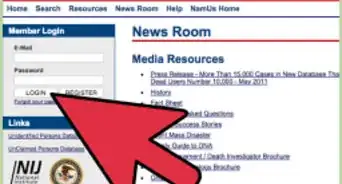wikiHow is a “wiki,” similar to Wikipedia, which means that many of our articles are co-written by multiple authors. To create this article, 57 people, some anonymous, worked to edit and improve it over time.
There are 20 references cited in this article, which can be found at the bottom of the page.
This article has been viewed 159,177 times.
Learn more...
Wars are a terrible reality of life. Worse still is that you, even if you oppose war, can be forced to fight through what is called a military draft. Many countries require men (and less often women) to serve in the military in war or even in peace. While we no longer have an active draft, all male US citizens and some male immigrants aged 18 to 25 must also register with Selective Service for a potential future draft within 30 days of turning 18. What are you to do? Rest assured that there are a few options – some legal, some illegal – that can help you to avoid fighting.
Steps
Seeking Legal Advice
-
1Consult a good lawyer. Evading a mandatory military service is a crime and often carries serious consequences. In one recent case, an Australian national was arrested and jailed in Israel for draft evasion; she had lived there for four years as a teenager.[1] Talk to a lawyer before you do anything. They can update you on the law and give you advice about your options.
-
2Research relevant cases. Look into the files of recent service evaders with your lawyer. In the US, for example, there have been a number of high-profile cases in the last ten years of soldiers refusing to serve. Some tried to flee to Canada[2] but have mostly been deported, ending up in legal trouble.[3] Although these men are legally deserters, not draft evaders, their stories can be helpful and give you a better sense of your options – and of the potential consequences of draft dodging.
- Recently, Polish men have been moving to Britain in order to escape the draft in their country, which is punishable by three years in prison. They have been able to do so because of fairly open freedom of movement between countries in the European Union.[4]
Advertisement -
3Assess your options. You are about to take a very serious and potentially life-changing step. Examine all of your options with a lawyer. Know the latest case law. Be sure that you are making the right choice and that you have a plan for all possible outcomes.
- Questions to consider include whether you have dual citizenship in a country not at war. It may be possible for you to go there. Are you gay, lesbian, bisexual, transgender, or intersex? Many militaries do not let such people serve in the military.
- Are you a member of a religious organization that is historically pacifist, like the Quakers, Mennonites, or Jehovah’s Witnesses? If so, you may qualify as a “conscientious objector” or someone who opposes war or violence by reason of religious belief.
- Do you have any physical or mental conditions that could prevent you from being drafted? Document them. Do you have a mild case of asthma? Go to the doctor once a month to get it on record. Whatever your condition, document it as much as possible. You will need to present comprehensive documentation.
Filing for Conscientious Objector Status
-
1File a written application. Conscientious objectors are excused from military service in many countries. In the US, they not only include members of pacifist churches like the Jehovah’s Witnesses, Quakers, Mennonites, and Amish but also anyone who claims, and can prove, to have a “firm, fixed and sincere objection to participation in war in any form or the bearing of arms, by reason of religious training and belief.” There are also two distinct classes: Class 1-O and Class 1-A-O. The first is for people who sincerely object to any participation in war whatsoever. The second group object to participation in war as combatants, but not to participation in a non-combatant role.
- To start the process, you will have to file a formal application. You will have to document your views and prove to the investigators of your claim that you are not objecting simply to avoid service or out of expedience. You have to show that your reasons are based on sincere belief. Your investigators will judge your participation in a religious organization, your pattern of conduct, whether your beliefs were shaped by serious ethical or moral study, and other factors.
-
2Attend your interviews and hearing. You will most likely be interviewed as part of the review of your conscientious objector application. Very probably you will have to speak with a psychologist, a military chaplain (a pastor, rabbi, or imam depending on your religious affiliation), and finally an investigating officer in a hearing. They will be judging the sincerity of your beliefs and whether your claim is credible. Again, you will have to give detailed information about your beliefs and their basis as well as your religious life. You may also be able to have third parties testify on your behalf.[5]
- Keep in mind that your interviews are not “privileged.” This means, for example, that they can ask confidential questions about you from a chaplain who knows you previously. In this case, you should request to be interviewed by a different chaplain.[6]
-
3Await the results of the informal investigation. After the interviews, the investigating officer will file a report on your case. This usually consists of items like statements and other documents received during the hearing, summaries of witness testimony, conclusions about the basis of your objections, and recommendations for your classification as a conscientious objector. The whole file will then be reviewed by a military judge advocate, and sent on to whatever headquarters makes the final decision.
- Since the US now has a voluntary military and requires you to swear an oath at your induction into the service, becoming a conscientious objector is hard. Basically, you have to be able to prove that your views on war changed after you swore the military oath.[7]
Filing a Refugee Claim
-
1Judge the chances of your case. It is hard to obtain refugee status to evade a draft. International law is not clear on the matter – refugees from military service are not included in the Geneva conventions nor necessarily excluded.[8] Rather, your case depends in part on your civil and legal status at home. Talk with a lawyer over the merits of your case, if you can, before taking the uncertain step of applying for refugee status.
- The UN considers there to be five situations when refugee status is appropriate: if the punishment for objecting from conscience amounts to “persecution”; if you have objected to military acts that are atrocities or violate standards of international law; if you object to military service in conditions that amount to torture or inhumane treatment; if you are fleeing recruitment by a non-state group and the state is unable to protect you; or if you are a child resisting illegal recruitment.[9]
-
2Choose a refuge country carefully. If you decide to pursue a refugee claim, be very careful with your choice of host country. You should file as a refugee in a country that will not send you back to your home country. For instance, the days of safely crossing the border to Canada as a US military objector are long over. While the legal landscape is not entirely clear, deserters and others can be arrested and deported to face trial under the terms of the current extradition treaty.[10] Countries that don’t often deport US citizens include Ecuador, Russia, and Venezuela.[11]
-
3Make an application. The next step is to file a formal application seeking protection as a refugee. If you are outside of your target country, you will probably file as a refugee to the closest at the nearest embassy or consulate; if you are already inside the country or at a port of entry, you will apply as an asylum seeker. As part of your application you will also have to present proof of your claims of persecution.[12]
- Make sure to consult an attorney at this stage, if possible. She can guide you through the sometimes complicated legal forms.
- Keep in mind that the approval process will be lengthy. In Canada, for example, wait times can be as long as 36 months.[13]
- You may not be able to work for part of this time, if you are allowed entry. In the United States, asylum applicants must wait 150 days before they can apply for work-status.[14]
Qualifying as Exempt, Deferring Service, or Refusing
-
1File for an exemption. Most countries make certain exemptions from conscription. For example, religious students in Israel were until recently exempt from the draft. You are exempt from a future draft in the United States under the following conditions: you are from a family in which a parent or sibling has died or is missing in military action; your absence would cause your family economic hardship; you are a minister; you are in school to be a minister; you are an immigrant or dual citizen.[15]
- Remember that the US does not currently have a draft. You can only file an exemption claim in the future, after getting orders to report, to the closest Selective Service office.[16]
- Some countries, including the US until recently, prohibit gay people from serving. This is still the case in Turkey, where, however, you have to submit “proof” of your status by answering questions, providing pictures, or worse. Making use of this exemption can get you out of a draft, but can be traumatic and humiliating.[17]
- Some countries also allow you to pay an exemption fee to get out of military service. In Turkey, this fee was recently lowered from 10,000 to 6,000 Euros. Still, the cost is so expensive that only well off families can afford it.
-
2Defer your service. If you are not exempt, you still may be able to put off entering the military. Many countries offer deferments for education, for example. According to US law, high school students may defer their service in any future draft until they graduate or reach the age of 20. College students may defer until the end of their term. You can defer your service until the end of your studies if you are becoming a minister.[18]
- The law in the United States also provides for appeals to draft status. If, in the event of a future draft, you file to change your draft classification, you automatically get a deferral until your claim is processed.[19]
-
3Refuse to serve. This is a final option. Just don’t do it. However, you will have to face harsh consequences for refusal. In the US, during wartime and peacetime drafts, people have been jailed for refusing to be inducted into the military. Muhammad Ali famously refused to be drafted to fight in the Vietnam War, for example, and he was indicted, sentenced to five years in prison, and stripped of his boxing titles. Under current law, men are required to register for selective service – for a future draft – and refusal to register is a criminal offense.
Community Q&A
-
QuestionIs the draft slavery?
 Community AnswerMany people feel this way; the difference, it would seem, is that drafted soldiers receive pay.
Community AnswerMany people feel this way; the difference, it would seem, is that drafted soldiers receive pay. -
QuestionHow old do I have to be to join the Marines?
 Community AnswerYou have to be at least 17 (with a parent's consent), or 18 (without a parent's consent) to join the USMC.
Community AnswerYou have to be at least 17 (with a parent's consent), or 18 (without a parent's consent) to join the USMC. -
QuestionWould it be enough to file a condition claim if I have somewhat severe asthma, so that even doing simple exercises makes it hard to breathe? I would mainly not be able to keep up with the others.
 Community AnswerYes, if you have a health problem, you wouldn't be drafted. The process of drafting someone involves a health check, asthma would stop you from going to war.
Community AnswerYes, if you have a health problem, you wouldn't be drafted. The process of drafting someone involves a health check, asthma would stop you from going to war.
Warnings
- Get information quickly so you can act in a timely manner.⧼thumbs_response⧽
- Act in an informed way, but act without delay.⧼thumbs_response⧽
References
- ↑ http://www.timesofisrael.com/australian-visiting-israel-jailed-for-draft-dodging/
- ↑ http://www.thestar.com/news/gta/2015/02/08/more-us-soldiers-could-be-sent-back-for-court-martial-on-desertion-charges.html
- ↑ http://www.ctvnews.ca/canada/u-s-soldiers-say-canada-no-longer-a-haven-for-war-resisters-1.2465569
- ↑ http://www.dailymail.co.uk/news/article-494661/Thousands-Poles-moving-Britain-avoid-national-service.html
- ↑ https://www.libertyinstitute.org/conscientious-objector-faq#Q9
- ↑ https://www.libertyinstitute.org/conscientious-objector-faq#Q8
- ↑ https://www.libertyinstitute.org/conscientious-objector-faq#Q3
- ↑ http://www.edcorrigan.ca/articles/refusal-to-perform-military-service-as-a-basis-for-refugee-claims-in-canada.html
- ↑ http://www.unhcr.org/52a715379.html
- ↑ http://www.theglobeandmail.com/news/world/us-war-resisters-experience-difficulties-finding-refuge-in-canada/article25476223/
- ↑ http://www.usnews.com/news/newsgram/articles/2013/06/24/snowden-runs-where-can-us-citizens-avoid-extradition
- ↑ http://www.nolo.com/legal-encyclopedia/asylum-or-refugee-status-how-32299.html
- ↑ http://www.cic.gc.ca/english/helpcentre/answer.asp?q=084&t=11
- ↑ http://www.uscis.gov/humanitarian/refugees-asylum/refugees
- ↑ https://www.sss.gov/Registration/Who-Must-Register/Chart
- ↑ https://www.sss.gov/About/Events-after-Draft
- ↑ http://www.bbc.com/news/magazine-17474967
- ↑ https://www.sss.gov/About/Return-to-the-Draft/Postponements-Deferments-Exemptions
- ↑ https://www.sss.gov/About/Return-to-the-Draft/Postponements-Deferments-Exemptions
- ↑ https://hasbrouck.org/draft/prosecutions.html
- ↑ http://www.centeronconscience.org/co/conscientious-objection-and-the-draft/320-selective-service-registration-coercion-of-conscience.html






































































